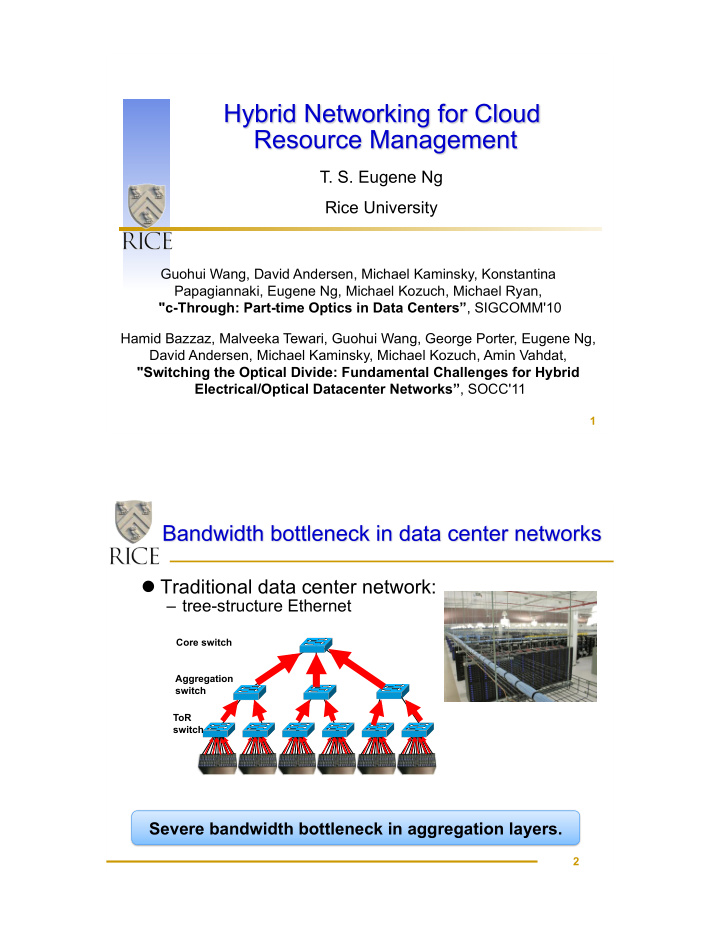



T. S. Eugene Ng Rice University Guohui Wang, David Andersen, Michael Kaminsky, Konstantina Papagiannaki, Eugene Ng, Michael Kozuch, Michael Ryan, "c-Through: Part-time Optics in Data Centers” , SIGCOMM'10 Hamid Bazzaz, Malveeka Tewari, Guohui Wang, George Porter, Eugene Ng, David Andersen, Michael Kaminsky, Michael Kozuch, Amin Vahdat, "Switching the Optical Divide: Fundamental Challenges for Hybrid Electrical/Optical Datacenter Networks” , SOCC'11 1 ! Traditional data center network: – tree-structure Ethernet Core switch Aggregation switch ToR switch Severe bandwidth bottleneck in aggregation layers. 2
a bird nest? HyperCube FatTree 1. Hard to construct 2. Hard to expand 3 ! Ultra-high bandwidth 40G, 100Gbps technology 15.5Tbps over a single fiber! has been developed. ! Dropping prices Price data from: Joe Berthold, Hot Interconnects’09 4
Electrical packet Optical circuit switching switching Switching Store and forward Circuit switching technology Switching 10Gbps port 100Gbps on market, is still the best practice capacity 15Tbps in lab Energy 12 W/port on 10Gbps 240 mW/port efficiency Ethernet switch Rate free Switching Packet granularity Less than 10ms time e.g. MEMS optical switch 5 ! Many measurement studies have suggested evidence of traffic concentration. – [SC05] : “… the bulk of inter-processor communication is bounded in degree and changes very slowly or never. …” – [WREN09]: “…We study packet traces collected at a small number of switches in one data center and find evidence of ON-OFF traffic behavior… ” – [IMC09][HotNets09]: “Only a few ToRs are hot and most their traffic goes to a few other ToRs. …” Full bisection bandwidth at packet level may not be necessary. 6
Electrical packet-switched network for low latency delivery Optical circuit-switched network for high capacity transfer ! Optical paths are provisioned rack-to-rack – A simple and cost-effective choice – Aggregate traffic on per-rack basis to better utilize optical circuits 7 Traffic demands ! Control plane: ! Data plane: – Traffic demand estimation – Dynamic traffic de-multiplexing – Optical circuit configuration – Optimizing circuit utilization (optional) 8
Configure VLAN to isolate electrical and optical network 1. Enlarge socket buffer to estimate demand. 2. De-multiplex traffic Centralized control for using VLAN tagging. circuit configuration Feasible to build a hybrid network without modifying Ethernet switches and applications! 9 MapReduce performance Gridmix performance Completion time (s) 900 800 700 600 500 400 153s 135s 300 200 100 0 128 50 MB 100 300 500 Full Electrical KB MB MB MB bisection network bandwidth c-Through Close-to-optimal performance even for applications with all-to-all traffic patterns. 10
Helios c-Through [SIGCOMM’10] [HotNets’09, SIGCOMM’10] • Pod level optical paths • Rack level optical paths • Estimating demand from switch • Estimating demand from server flow counters socket buffer • Traffic control by modifying • Traffic control in server kernel switches Others • Proteus [HotNets’10] : all optical data center network using WSS • DOS [ANCS’10] : all optical data center network using AWGR 11 ! Sharing is the key of cloud data centers Data processing • Share at fine grain Database • Complicated data dependencies Web server • Heterogeneous applications 12
1. Treating all traffic as independent flows – Suboptimal performance for correlated applications 2. Inaccurate information about traffic demand – Vulnerable to ill-behaved applications 3. Restricted sharing policies – Limited by the control platform of Ethernet switches 13 ! Effect of correlated flows 14
! Problem formulation Basic configuration: a Modeling correlated traffic: matching problem Definition of correlated edge groups: Graph G: (V, E) w xy = vol(Rx, Ry) + vol(Ry, Rx) EG = {e 1 , e 2 , …, e n } , so that R2 w 12 w(e i ) += ! (e i ), i = 1, …, n R1 w 27 w 14 when EG is part of the matching. R4 w 43 R3 R5 w 35 w 38 Conflicting edge groups: w 47 R8 w 36 w 68 Two edge groups are conflict if they R6 have edges sharing one end vertex. R7 Maximum weight matching with correlated edges 15 ! If there is only one edge group – Intuition: test if including the edge group in the match will improve the overall weight. – Equation: Accept Not accept ! If no conflict among edge groups: – A greedy algorithm • Iteratively accept all the edge groups with positive benefits; • Proven to achieve maximum overall weight; 16
! If there are conflicts among edge groups – Finding the best non-conflict edge groups is NP-hard. • Equivalent to maximum independent set problem. – An approximation algorithm based on simulated annealing works well. 17 ! Locations known, demand unknown: – Measuring maximal number of non-conflicting edge groups in each round. 18
! Location unknown, demand unknown: – Hard problem 19 ! Effect of bursty flow 20
! An example problem: – Random hashing over multiple circuits. 4 circuits • Hash collision Hashing 4 flows • Limited to random sharing ! Potential solution: – Flexible control using programmable OpenFlow switches. 21 ! HyPaC architecture has lots of potentials by marrying the strengths of packet and circuit switching ! Lots of open problems in the HyPaC control plane ! New physical layer capabilities (e.g. optical multicast) bring additional benefits and challenges 22
Recommend
More recommend